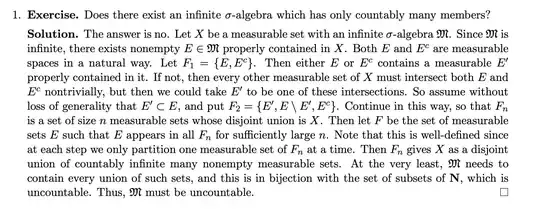There is the exercise:
Does there exist an infinite $\sigma$-algebra which has only countably many members?
Intuitively I think that the answer is no but I've really trouble to proof it.
 This is one proof But I have few questions about it.
I don't understand this part in this proof: " If not, then every other measurable set of $X$ must intersect both $E$ and $E^c$ nontrivially."
This is one proof But I have few questions about it.
I don't understand this part in this proof: " If not, then every other measurable set of $X$ must intersect both $E$ and $E^c$ nontrivially."
I also don't understand why is $F_n$ a set of size $n$ measurable sets? for example $F_2$ has three members . by this logic $F_n$ should have $n+1$ members. why do we need to make $n$ sufficiently large? Any help would be appreciated.